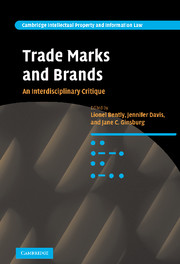Book contents
- Frontmatter
- Contents
- List of figures and tables
- Notes on the contributors
- Editors' preface
- Table of cases
- Table of statutes
- Part I Legal and economic history
- Part II Current positive law in the EU and the USA
- Part III Linguistics
- Part IV Marketing
- Part V Sociology
- 9 Trade mark style as a way of fixing things
- 10 The irrational lightness of trade marks: a legal perspective
- Part VI Law and Economics
- Part VII Philosophy
- Part VIII Anthropology
- Part IX Geography
- Bibliography
- Index
- Titles in the series
9 - Trade mark style as a way of fixing things
Published online by Cambridge University Press: 13 April 2010
- Frontmatter
- Contents
- List of figures and tables
- Notes on the contributors
- Editors' preface
- Table of cases
- Table of statutes
- Part I Legal and economic history
- Part II Current positive law in the EU and the USA
- Part III Linguistics
- Part IV Marketing
- Part V Sociology
- 9 Trade mark style as a way of fixing things
- 10 The irrational lightness of trade marks: a legal perspective
- Part VI Law and Economics
- Part VII Philosophy
- Part VIII Anthropology
- Part IX Geography
- Bibliography
- Index
- Titles in the series
Summary
Introduction
This chapter will focus on the implications of recent developments in trade mark law for branding. It will address how the logo, as a sign of the brand, is legally constituted as a trade mark – that is, as a kind of intellectual property – and how this legal constitution as property supports the valuation and exploitation of the brand as a commercial asset. The focus will be on the role of trade mark law in the organization of relations between firms in producer markets rather than on the relations between firms and final consumers that has been the focus of my own and much other previous work on brands. It will be argued that the law contributes to the action of the brand as a new market modality or market cultural form, helping to organize the rise of a trade mark style of management. It will thus be suggested that trade mark law is a significant actor in the organization of producer markets, operating so as to consolidate and legitimate the use of branding as an object or mode of capital accumulation in a mediated economy.
What is a market?
There are many kinds of markets, but the concern here will be with what have been called producer markets. As the sociologist Harrison White points out, an increasing number of markets are more than sites for direct transactions between buyers and sellers.
- Type
- Chapter
- Information
- Trade Marks and BrandsAn Interdisciplinary Critique, pp. 201 - 222Publisher: Cambridge University PressPrint publication year: 2008
- 4
- Cited by



